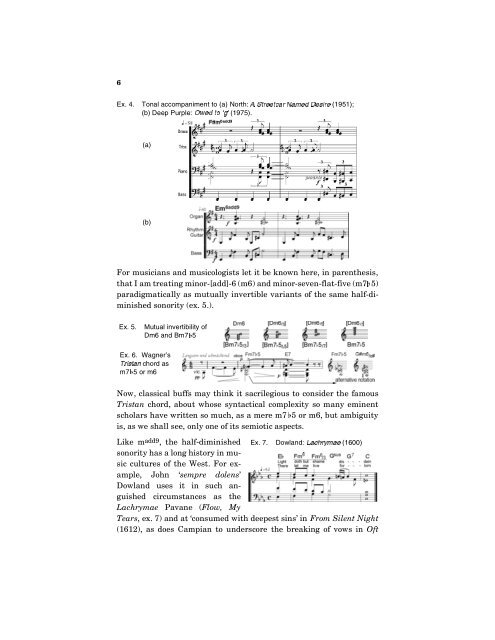Create successful ePaper yourself
Turn your PDF publications into a flip-book with our unique Google optimized e-Paper software.
6<br />
Ex. 4. Tonal accompaniment to (a) North: A Streetcar Named Desire (1951);<br />
(b) Deep Purple: Owed to ‘g’ (1975).<br />
(a)<br />
(b)<br />
For musicians and musicologists let it be known here, in parenthesis,<br />
that I am treating minor-[add]-6 (m6) and minor-seven-flat-five (m7$5)<br />
paradigmatically as mutually invertible variants of the same half-diminished<br />
sonority (ex. 5.).<br />
Ex. 5. Mutual invertibility of<br />
Dm6 and Bm7$5<br />
Ex. 6. Wagner’s<br />
Tristan chord as<br />
m7$5 or m6<br />
Now, classical buffs may think it sacrilegious to consider the famous<br />
Tristan chord, about whose syntactical complexity so many eminent<br />
scholars have written so much, as a mere m7$5 or m6, but ambiguity<br />
is, as we shall see, only one of its semiotic aspects.<br />
Like madd9, Lachrymae the half-diminished<br />
sonority has a long history in music<br />
cultures of the West. For ex-<br />
Ex. 7. Dowland: (1600)<br />
ample, John ‘sempre dolens’<br />
Dowland uses it in such anguished<br />
circumstances as the<br />
Lachrymae Pavane (Flow, My<br />
Tears, ex. 7) and at ‘consumed with deepest sins’ in From Silent Night<br />
(1612), as does Campian to underscore the breaking of vows in Oft














